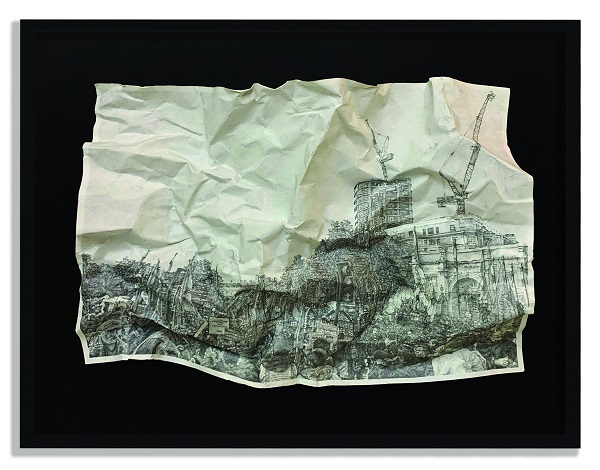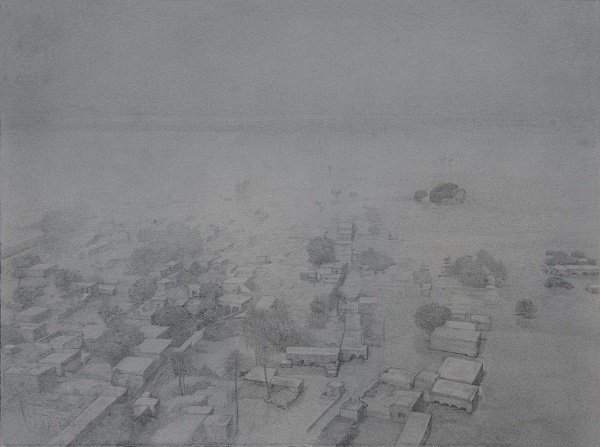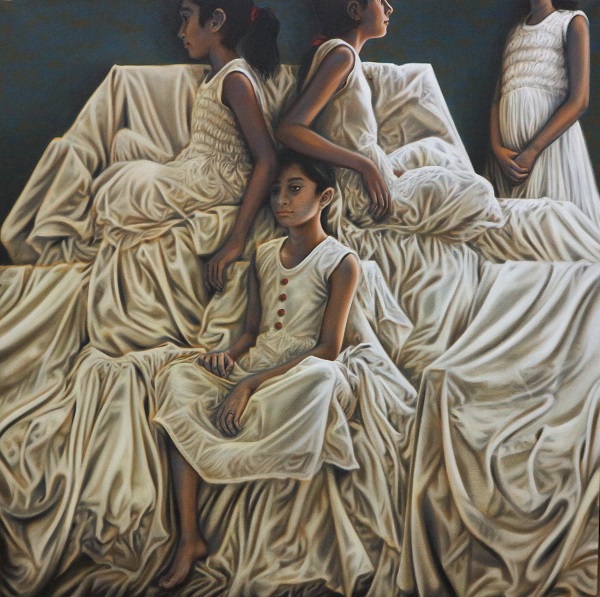Written by: Nayha Jehangir Khan
Posted on: May 03, 2021 | 
Banana Dreams by Ahsan Javaid
The country is in the grips of the third-wave of a global pandemic, and with strict lockdowns being placed the future is uncertain. The time for viewing art online is becoming an invaluable practice, as the only way to traverse international borders is through a digital showcasing. The project “Virtual Reality” is a collaboration between the Lahore art gallery O Art Space, Studio RM & River Halls in Singapore. Together, they are showcasing works of art on their website, ArtDekho.com. The platform signals a rise of art e-commerce as a substantial way to sell artworks to an international clientele. The website is only based virtually for the purpose of promoting affordable South Asian art to a wider viewership.
The artworks were “uploaded” on the 28th of April, 2021 during a kind of a virtual opening with 37 works available for sale. When scrolling past the works of each artist, the website format feels minimal and clear, much like viewing the paintings in a gallery. The colours are crisp, the details are sharp and one can spend as much time as they want on each piece, reading into its concept and narrative. It is satisfying to be able to click on art works that intrigue and delight the eyes, in order to get to know more about the artist behind the work.
The format is digital but the presentation feels tactile and intimate, while the artists’ profiles feel friendly and approachable. This comes as a relief during a time when visiting galleries has become difficult. Although O Art Space will continue to host physical exhibitions with strict SOPs, their collaboration with River Halls marks an opportunity to take their space into the virtual realm, and encourage artists to keep creating and showcasing their work.
There are several identifiable themes in this virtual exhibit, starting with the urbanscapes of Kiran Waseem, Ahsan Jamal, Haider Ali Naqvi and Hamid Ali Hanbi. These artists are taking an anthropological and fossilised approach to their image making. Waseem and Jamal paint views from what could be a moving car window, using painterly strokes to capture light, speed, and vastness of the open road. Naqvi’s and Hanbi’s drawings are made with graphite, showing abandoned layouts of towns. The silence in their work is palpable, deliberately removing any human representation from the frame. We are left with an emotional resonance of isolated architecture that feels symbolic and nostalgic.
The social commentary in the paintings of Mina Mohsin and Ahsan Javaid have overly exaggerated objects, patterns, colours, and subjects that originate from an anthology of memories and thoughts. Mohsin’s table spreads of treats and snacks are reminiscent of the Mad Hatter’s tea party, with the details like a hostess trolley. It is an instantly recognizable emblem of hosting dinners in the 1980’s, while the tea-time spread is romantically centred with a bouquet of pink roses. On the other hand, Javaid's paintings have subjects placed inside a strange wonderland with a field of bananas, and grass with bright neon colours. In his painting “Find The Real”, he uses an LED light to create carbon copies, reducing the painting down to line and form.
Though the ornamental gold paint has historical roots in miniature, it is transformed into a contemporary painting device by artists M. Noman Siddiqui, Abid Aslam and Mudassar Manzoor. Siddiqui creates small objects with engravings of Mughal era flower pots and elephants, Aslam has silhouettes of Mughal warriors in combat, whereas Manzoor has an impression of a figure with a resting gold butterfly. The mysticism is shrouded in miniature history where the textures, strokes and control over their individual mediums create movement within the frame. There is a story unfolding in these works, a tale of an unsung hero amidst the chaos of an older or forgotten time.
Sana Saeed and Ali Azmat have interestingly chosen female protagonists for their monochrome paintings, whereas Sobia Ahmed and Irfan Gul Dahri have beastly creatures like cats and birds morphed into a human presence on canvas. Saeed often creates duos or tableaus in her paintings of female subjects. Her painting “Still Life”, is maternal and communal, showing a group of girls dressed in the same white outfit resting on a white sofa. Azmat has a model posing in a traditional life drawing studio setting. In “Dialogue I”, the model is holding a silhouette outlined in the shape of a bird left unfinished, blank and white contrasting element from the finely drawn and blended graphite rendering. The series shows the model looking away from the viewer, eventually clasping her hands together gazing above, the light on her face is strong, singular and clear.
Sameen Agha’s practice of portraiture is ephemeral, her pieces capture a likeness of her childhood with glimpses of scenes paired with snippets of macro shots. Are these special occasions from his own childhood or scenes from her current life, the ambiguity personalises these artworks as the viewer imagines the two pictures coming together and creating a unique emotion every time. There is a surreal reality in Akif Suri’s paintings that pair natural skin with a celestial egg shaped object at the centre. There is a tension between the stretched skin and egg confronting vulnerability within ourselves. Sadqain deconstructs materiality of a home by presenting a house as a pile of bricks, stripping away facade, boundaries and embellishment.
The online exhibition is showcasing three works from each artist allowing the viewer to gain an in-depth sense of their art practice. Simply visit https://artdekho.com/ to view the entire collection.



You may also like: